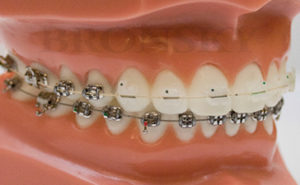During orthodontic treatment it is important to take care of the health of your teeth, gums and mouth. Plaque can cause dental challenges and have an effect on your orthodontic treatment if you don’t keep it under control. A buildup of plaque could extend the length of your orthodontic treatment and cause adverse dental challenges while you’re wearing braces too. Keeping plaque under control can be a little trickier with braces, but the right tools and techniques will help you to keep your teeth clean. Understanding how plaque impacts your orthodontic treatment will mean that you know why and how to protect your teeth.
Problems During Treatment Caused By Plaque
Plaque and the hardened form of plaque called tartar, can cause a range of adverse reactions.
When plaque builds up, it can lead to gum disease, decalcification (when your teeth lose calcium) and cavities (holes in your teeth).
Plaque and tartar increase the bacteria in the mouth, which can inflame the gums and cause infection.
When you have braces, there can be a higher chance of plaque and tartar building up because you’re not cleaning your teeth adequately or flossing correctly.
It’s important to learn how to take care of your teeth with braces and learn how to clean around them.
When your oral health deteriorates, it can make it difficult to keep your orthodontic treatment on the right path.
Your dentist and orthodontist will advise how to deal with these issues, which in some severe cases could even mean that your braces are removed in the middle of treatment.
This may be necessary to allow your dentist to clean the plaque or tartar away, clean your gum line and allow time for the bacterial inflammation to reduce.
Other issues as well may lead to your braces needing to be removed or altered.
For example, if a cavity or an infection requires a tooth to be extracted or you require a root canal treatment, wearing braces makes this more complicated.
If your orthodontic treatment needs to be delayed due to dental health challenges, it could disrupt the whole process and perhaps even make your orthodontic treatment take longer.
The best outcome for your orthodontic treatment is that it is completed without any disruptions, so looking after your oral health plays a big role in successful treatment.
The Impact Of Plaque After Orthodontic Treatment
Plaque doesn’t just have the potential to cause problems during your orthodontic treatment.
You might also experience issues after treatment once your braces have been removed.
If you’ve had problems with plaque whilst wearing braces, you may also have experienced decalcification which is when your teeth lose calcium and leave white marks on your teeth, or calculus which can lead to cavities.
“Understanding how plaque impacts your orthodontic treatment will mean that you know why and how to protect your teeth.”
You could have your braces removed and discover that there are stains from the plaque that has built up.
If you want to prevent these problems from happening, you need to make sure that you take good care of your teeth during your orthodontic treatment.
9 Ways To Fight Plaque For A Smooth Orthodontic Treatment
There are various methods that you can use to prevent the buildup of plaque.
Daily brushing and flossing are habits that you should already have, but you might have to adjust your oral hygiene routine when you have braces.
Good oral hygiene will keep plaque away, and both you and your dentist can help to prevent plague build up.
- When you brush your teeth, make sure to remove elastics and other removable appliances such at plates.
- Clean your braces by brushing each bracket and cleaning around wires and hooks.
- When you brush your teeth, make sure it’s for at least two minutes, placing emphasis on your back teeth and your gum line.
- When you’re finished, you can use a mineralisation treatment like dental mousse which can assist with decalcification.
- Orthodontists often recommend the use of an electric toothbrush over a manual one, as it reaches between the braces far more thoroughly.
- Flossing when you have braces can feel a little more difficult, but there are some tools that you can use to help, such as superfloss. If you’re using normal dental floss, a floss threader can help you to get the floss around your braces. A waxed floss will be less likely to get stuck.
- Using interdental brushes once a day will also help you to clean between your teeth and around your braces.
- They are available in different sizes, and you can bend them if you need to reach more difficult areas.
- Some people also find a water flossing tool is easier to use than regular floss.
Don’t forget…
It’s also important to keep up regular visits to your general dentist during your orthodontic treatment.
Your dentist can carry out professional cleaning and polishing to remove plaque and tartar.
Your orthodontist is a specialist in correcting teeth alignment and related orthodontic challenges, so you still need to see your regular dentist whilst you’re having orthodontic treatment.
Follow these tips and you’ll complete your orthodontic treatment on time!





